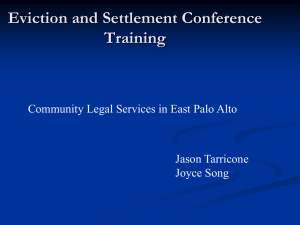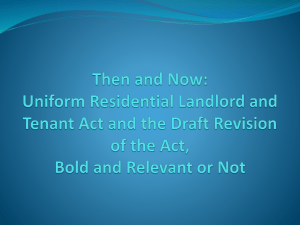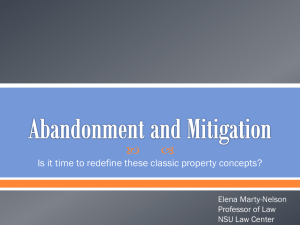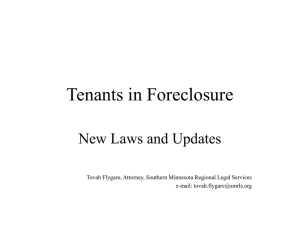Eviction - PLE Learning Exchange
advertisement
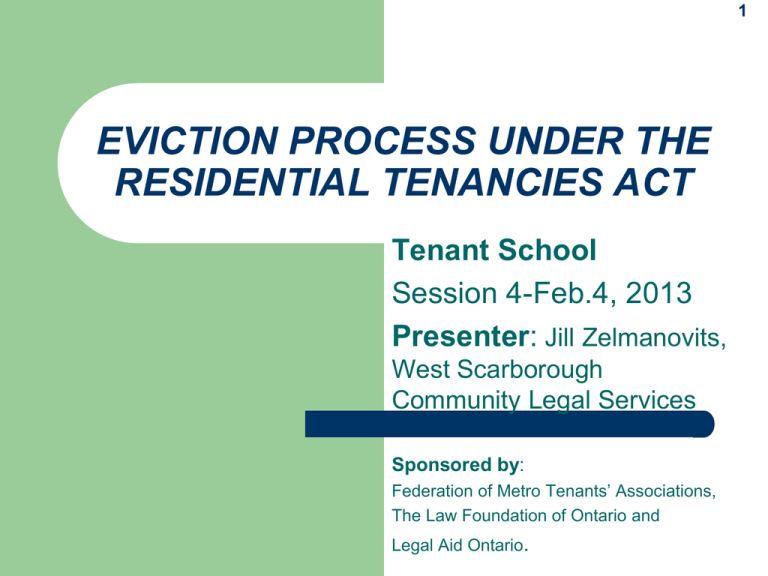
1 EVICTION PROCESS UNDER THE RESIDENTIAL TENANCIES ACT Tenant School Session 4-Feb.4, 2013 Presenter: Jill Zelmanovits, West Scarborough Community Legal Services Sponsored by: Federation of Metro Tenants’ Associations, The Law Foundation of Ontario and Legal Aid Ontario. 2 What will be covered Legal Reasons for Eviction The Eviction Procedure Preventing Evictions Agreements / Mediation/ Consent Orders Disputing Eviction Applications Execution of the Order Motion to Set Aside Ex-parte Orders and Stays Review and Appeal of an Order Resources for Tenants 3 In your handouts CLEO: – – – – What Tenants need to know about the Law Fighting an Eviction Can your Landlord take your Stuff? Community Legal Clinics in Ontario List of Tip Sheets for Tenants created by ACTO Sample Notice of Termination Sample Application to Terminate Sample Notice of Hearing Sample Notice from the LTB Sample Order by LTB Sample Sheriffs Notice 2 Charts of the Eviction process 4 Basics A. Grounds – Landlords must have a ground specified in the Residential Tenancies Act (RTA) to evict a tenant. B. Procedure - Landlords must follow a procedure specified in the Residential Tenancies Act (RTA) to evict a tenant. LLs cannot change the locks, turn off heat or utilities or try to force tenants out without an Order from the Landlord and Tenant Board (LTB). C. Eviction is a serious matter and is considered a remedy of last resort so the RTA provides protection from unlawful eviction. D. In many cases, tenants can prevent eviction. 5 Eviction Procedure Step 1: Step 2: Step 3: Step 4: Step 5: Step 6: Step 7: Step 8: Step 9: Review / Appeal of an Order Notice of Termination Application to Terminate a Tenancy Preventing Eviction /Agreements/ Consent orders/ Mediation Disputing the Application The Hearing at the LTB The Eviction Order Preventing Eviction after the LTB makes an Eviction Order The Sheriff – Enforcement of an Order 6 Step 1 - Notice of Termination 3 Common Legal Grounds for Eviction: #1) Early Termination for Cause - Regular #2) Early Termination for Cause - Fast Track #3) Termination at End of Term 7 Step -1 #1) Early Termination for Cause-Regular A. Non-payment of rent (Notice-N4)(Application-L1) B. Damage to the unit or common areas(Notice-N5)(Application-L2) C. Overcrowding D. Misrepresentation of Income (subsidized housing tenants) (Notice-N5)(Application-L2) (Notice- N6)(Application-L2) E. Illegal act, illegal trade, business or occupation(Notice-N6)(Application-L2) F. Substantial interference with reasonable enjoyment, or lawful right, privilege or interest (Notice-N7)(Application-L2) G. Impaired Safety(Notice-N7)(Application-L2) 8 Step -1 Continued #2) Early Termination for Cause - Fast Track A. Illegal act or business involving drugs (NoticeN6)(Application-L2) B. Willful and undue damage (Notice-N7)(Application-L2) C. Use inconsistent with a residential premises that causes or is likely to cause significant damage (Notice-N7)(Application-L2) D. Substantial interference, in small buildings and where the landlord lives in the same building (NoticeN7)(Application-L2) E. Serious Impairment of safety (Notice-N7)(Application-L2) 9 Step - 1 Continued #3) Termination at End of Term A. Persistent late payment of rent(Notice-N8)(Application-L2) B. Landlord’s or purchaser’s own use (Notice-N8) (Application-L2) C. Demolition, conversion, major repairs or renovations (Notice-N8)(Application-L2) D. Ceasing to qualify (subsidized housing tenants) (NoticeN8) (Application-L2) E. Employment ended (Notice-N8)(Application-L2) F. Condominium purchase that fell through (Notice-N8) (Application-L2) 10 Step 1: continued Notices of Termination – Procedural Requirements Tenants must receive a notice from the landlord to terminate the tenancy. The notice must include specific information to be valid. The notice must follow specific timelines related to the reason for termination and the rental period in order to be valid. Notices are only valid for 30 days from the date they state the unit must be vacated except for notices for non-payment of rent. Notices that are not valid can be challenged by the tenant and do not result in an eviction. 11 Step 1: continued Notice of Terminations – legal requirements for all Landlord must allege that the tenant has done something wrong. Landlord must provide details about the problem that the notice alleges. Tenant does not have to move out when the tenant receives a notice because a notice is only an allegation which must be proven at the LTB. 12 Step 1: continued Notice of Terminations – special requirements Voidable notices – – Fast Track evictions notices – – – In some cases, tenants are permitted to take steps to void the notices by complying with the terms of the notice. If notices are voided, the landlord cannot file an application for termination for that act. Tenant cannot void these notices The notice periods are very short Hearings are scheduled very quickly End of Term Termination notices – The notice period must end with the last day of the lease if it has a term OR the last day of a rental period if the tenant pays rent monthly. 13 STEP 2: Application to terminate a Tenancy – L1, L2 & L9 Filing of the Notice of Application at the LTB Letter from the LTB Notice of Hearing must be served on the Tenant for a) L1: application to evict a tenant for non-payment of rent and to collect the rent the tenant owes. b) L2: application to terminate a tenancy for all reasons other than arrears including early termination for cause, fast track evictions and termination at end of term. c) L9: application to collect the rent a tenant owes without eviction. 14 STEP 2: Application to terminate a Tenancy – L3 & L4 No letter from LTB to tenants Notice of Hearing may not be required to be served on Tenant for: a) L3: application to terminate a tenancy where the tenant gave notice or agreed to terminate the tenancy and did not move out. b) L4: application to terminate a tenancy where the tenant failed to meet the conditions of a consent order or mediated settlement. 15 STEP 3: Preventing Eviction Voidable notices - Avoid going to the LTB and prevent eviction by complying with the requirement of the notice of termination, before the date specified in the notice. Avoid paying the $170.00 fee. 16 Step 3: Preventing Eviction – L1 Applications – Settlements & Consent Orders After the Landlord files the application, the Tenant can avoid eviction in non-payment of rent matters by: – – – – – Entering into a payment plan, in writing, with the landlord before the hearing. s. 78 clauses – must be able to pay The parties can file their settlement with the LTB which may issue a consent order in terms of the settlement. If the tenant does not meet the conditions of the consent order the landlord may request to re-open the matter. Tenant will receive Notice of a Hearing if the Landlord reopens the matter. 17 STEP 3 - preventing eviction - L1 Application - Arrears of Rent – After the Landlord files the application the Tenant can avoid eviction in non-payment of rent matters: – By paying off before the hearing date (1) the entire arrears, (2) the rent for the month in which the hearing is scheduled and (3) the application fee of $170. – After the order is issued – pay the amount specified in the order on or before the date specified in the order, to the landlord or the LTB. 18 Step 3:Preventing Eviction - Mediation Who is a mediator Mediation is voluntary No order of LTB Why mediation? What can it cover? – – can be used to try and work out a payment plan or other solutions to resolve the issues in the application or other issues a mediated agreement can include termination of the tenancy 19 STEP 3: Preventing Eviction– for TCHC tenants TCHC – Eviction Prevention Policy and Eviction Prevention Policy Guidelines Negotiate payment plan Contact legal clinic 20 Step 4: Disputing the Application L1 AND L2 APPLICATIONS – – – – – – – tenant must attend the hearing written dispute not mandatory but optional duty counsel at LTB request adjournment to prepare case or obtain legal counsel Landlord must prove allegations Tenant must prove defence Section 83 arguments 21 Step 4: Disputing Continued Arrears of Rent application – L1 Tenants must appear at the hearing prepared to prove that the rent has been paid or provide a legitimate reason for why it has not been paid such as the fact that the landlord is not maintaining the building or the rental unit properly. Tenants must prove that there are maintenance problems. The LTB may order a reduction in rent for poor maintenance that offsets or completely covers the amount of rent owed depending on how serious the lack of maintenance is. The LTB may refuse to order an eviction if the landlord refused to make repairs and the tenant withheld rent to force repairs to be made. 22 Step 4: Disputing Continued Section 83 Arguments Tenants can argue that even though there are rent arrears, the tenant should not be evicted because of compassionate grounds including that the tenant: a) b) c) d) lived in the unit for a long time; has children so should not be moved; suffers from physical or mental disabilities (Human Rights issues); and/or has a strong connection to community. 23 Step 4 – Disputing an L2 Application Tenants must appear at the hearing prepared to dispute the landlord’s allegations regarding damage, overcrowding, illegal act, impaired safety, interference with reasonable enjoyment, misrepresentation of income or ceasing to qualify. Tenants must provide evidence to support their version of events or to contradict the landlord’s version of events (police reports, witnesses to testify, witness statements) 24 Step 4: Disputing the application Continued L3 AND L4 APPLICATIONS – – – – – – – – Motion to set aside an exparte order Time limit – 10 day Stay of execution of order in writing Appearance of tenant Mediation Duty counsel at LTB Disputing the Landlords allegations Section 83 arguments 25 Step 4 – Disputing Continued L3 Application – steps to disputing L3 Application – Alleged Tenants notice to terminate Motion to set aside an ex-parte order of eviction made on an L3 application must be made within 10 days of the receipt of the order or request an extension of time. No fee. The tenant must request the stay of the execution of the order. Serve the Stay on the Sheriff Serve the Landlord with the Notice of Hearing Tenants must provide evidence that they did not give notice or enter into an agreement with the landlord to terminate the tenancy or that the notice was coerced. 26 Step 4 – Disputing Continued L4 Application - Steps to disputing L4 – When a tenant breaches a mediated settlement or consent order previously negotiated at the Landlord and Tenant Board. Motion to set aside an ex-parte order of eviction made on an L4 application must be made within 10 days of the receipt of the order or need to also request an extension of time. The tenant must request the stay of the execution of the order Serve the Stay on the Sheriff. Serve the Landlord with the Notice of Hearing. Tenants must provide evidence that they did not breach the terms of the agreement or consent order. 27 Step 5: The Hearing at the LTB The LTB is required to review all the circumstances and even if the landlord has proven its case, will refuse to grant the eviction if it is fair to the parties. The LTB cannot grant the eviction if the tenant can prove: the landlord is in breach of its obligations the reason for the application is that the tenant complained to a government authority about the landlord’s violation of health, safety or housing or maintenance standards the reason for the application is that the tenant has attempted to enforce his/her legal rights the reason for the application is that the tenant is a member of a tenant association or is attempting to organize one the reason for the application is that the unit is occupied by children and there is no overcrowding 28 Step5 –The Hearing at the LTB Tenants proving their case oral testimony of tenant; oral or written testimony of witnesses; Pictures/videos; expert reports; receipts and cancelled cheques; and/or any written agreements or other documents or papers that support the tenant’s claim. 29 Step 6: The Eviction Order The adjudicator issues an order after the hearing. Can be issued on the same day verbally followed by a brief written order. Parties will receive a written order in the mail from the LTB. Parties can ask that the Adjudicator give detailed reasons for their order. The adjudicator may – – – – – – – Dismiss the application of the landlord Allow the application of the landlord Give time to the tenant to vacate the premises Give time to the tenant to pay the arrears. (standard =11 days) Refuse to grant eviction even if there were grounds of eviction Order the landlord to do repairs Pass any other order that the Tribunal feels fair and just in the circumstances Validity of Order – 6 months from the date of the Order. 30 Step 7 - Preventing eviction after order is made – L1 applications (Arrears) To prevent eviction the tenant can: Before the order is enforceable – pay the amount specified in the order on or before the date specified in the order to the Landlord or to the LTB in trust. After the order is enforceable – pay the amount specified in the order, NSF charges if any, any additional rent that may be owing before the sheriff enforces the order plus the sheriff’s fees if the landlord has already paid them. The tenant must obtain an order to void the eviction order. • This does not apply in case of mediated settlements • Tenant can use this only once in their tenancy. 31 Step 7 - Preventing eviction after order is made – L2 applications To prevent eviction the tenant can, before the order is enforceable, comply with the conditions as stated, on or by the date specified, in the order. For example: – – – – . Reduce the number of occupants in case of overcrowding Pay the landlord the cost of repairing or repair the damage as ordered. Remove the pet causing allergies to the Landlord. Pay the rent on the first of the month for the time period ordered. 32 Step 8: The Sheriff - Enforcement of an Order Once an eviction order is issued by the LTB, the landlord can enforce the eviction by filing the Order with the Sheriff. This means the Sheriff will come and change the locks. The landlord must file the Order with the Sheriff while the order is valid. Tenants have 72 hours from the time the eviction order is enforced (locks are changed) to reclaim their possessions. The landlord must provide Tenants with access between 8:00 a.m. and 8:00 p.m. Tenants can apply to the LTB if the landlord does not provide access. 33 Step 9: Review/Appeal of the Order If either the landlord or the tenant is unhappy with a decision made by the LTB, they have 30 days to: Review – ask the board to review the decision internally where there is a serious error in law or material fact OR if the tenant was not able to participate in the hearing ($50) Appeal – go to court where there is an error in law only CLIENTS SHOULD GET LEGAL ADVICE IMMEDIATELY. DO NOT WAIT UNTIL THE LAST DATE TO GET ADVICE. 34 Quiz time – TRUE OR FALSE Tenants cannot be evicted in the winter. Tenants can be evicted because they have children. Tenants can be evicted for damage to the unit because they caused it and refuse to repair it. Landlords can evict a tenant for having pets in their unit. Tenant must vacate the premises on the date mentioned on the Notice of Termination. Tenant is not responsible for the noise and disturbance caused by their guest in their unit or in the common areas of the building. Once the LTB makes an order terminating the tenancy for Non-Payment of Rent the Tenant must vacate the premises. The Landlord can change the locks after the LTB makes an order for termination. A tenant has 48 hrs to remove your belongings after the Sheriff has executed the order of the LTB. A landlord and tenant can legally only enter into one mediated settlement. 35 Quiz time – Answer Tenants cannot be evicted in the winter. - False Tenants can be evicted because they have children. - False Tenants can be evicted for damage to the unit because they caused it and refuse to repair it. - True Landlords can always evict a tenant for having pets in their unit. - False Tenant must vacate the premises on the date mentioned on the Notice of Termination. - False Tenant is not responsible for the noise and disturbance caused by their guest in their unit or in the common areas of the building. - False Once the LTB makes an order terminating the tenancy for Non-Payment of Rent the Tenant must vacate the premises.- False The Landlord can change the locks after the LTB makes an order for termination. -False A tenant has 48 hrs to remove belongings after the Sheriff has executed the order of the LTB. - False A landlord and tenant can legally only enter into one mediated settlement. - False 36 Resource for tenants Telephone Contact List Investigation and Enforcement Unit (Ministry of Municipal Affairs and Housing) (416) 585-7214 Landlord and Tenant Board 1-888-377-8808 Tenants Hot Line (FMTA) (416) 921-9494 City of Toronto Property Standards Department 311 (City of Toronto government) 37 Resources Continued WEBSITE INFORMATION Landlord and Tenant Board – www.ltb.gov.on.ca/ Property Standards, City of Toronto http://www.toronto.ca/apartmentstandards/home.htm Advocacy Center for Toronto – Federation of Metro Tenants Association – www.torontotenants.org/ Legal Aid Ontario for the Legal Clinic in your area http://legalaid.on.ca/en/ www.acto.on.ca/

